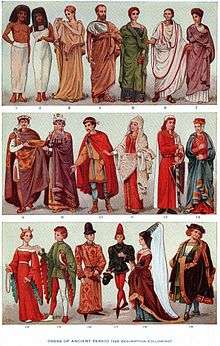Headgear
Headgear, headwear or headdress is the name given to any element of clothing which is worn on one's head.

Headgears serve a variety of purposes:
- protection (against impact, cold, heat, rain and other precipitation, glare, sunburn, sunstroke, dust, contaminants, etc.)
- to keep hair contained or tidy (including scrunchies, ball caps, etc.)
- decoration or fashion
- religious purposes
- medical purposes - for example orthodontic headgear
- modesty; social convention
- distinction; a badge of office
- sport uniform
Overview of headgear types
Bonnets

Bonnets, as worn by women and girls, were hats worn outdoors which were secured by tying under the chin, and often which had some kind of peak or visor. Some styles of bonnets had peaks so large that they effectively prevented women from looking right or left without turning their heads. Bonnets worn by men and boys are generally distinguished from hats by being soft and having no brim—this usage is now rare (they would normally be called caps today, except in Scotland where the "bunnet" is common in both civilian life and in the Royal Regiment of Scotland).
Caps
Caps are generally soft and often have no brim or just a peak (like on a baseball cap). For many centuries women wore a variety of head-coverings which were called caps. For example, in the 18th and 19th centuries a cap was a kind of head covering made of a flimsy fabric such as muslin; it was worn indoors or under a bonnet by married women, or older unmarried women who were "on the shelf" (e.g. mob-cap). An ochipok is part of traditional Ukrainian costume.
Crowns
Some headgear, such as the crown, coronet, and tiara, have evolved into jewelry. These headgear are worn as a symbol of nobility or royal status. Kokoshnik is part of Russian traditional dress, often worn by nobility.
Fillets
A fillet or circlet is a round band worn around the head and over the hair. Elaborate and costly versions of these eventually evolved into crowns, but fillets could be made from woven bands of fabric, leather, beads or metal. Fillets are unisex, and are especially prevalent in archaic to renaissance dress.
Hair covers
Hairnets are used to prevent loose hair from contaminating food or work areas. A snood is a net or fabric bag pinned or tied on at the back of a woman's head for holding the hair. Scarves are used to protect styled hair or keep it tidy. Shower caps and swim caps prevent hair from becoming wet or entangled during activity.
Hats

Hats often have a brim all the way around the rim, and may be either placed on the head, or secured with hat-pins (which are pushed through the hat and the hair). Depending on the type of hat, they may be properly worn by men, by women or by both sexes.
Helmets
Helmets are designed to protect the head, and sometimes the neck, from injury. They are usually rigid, and offer protection from blows. Helmets are commonly worn in battle, on construction sites and in many contact sports (most commonly being associated with American football). In most of the United States they are required by law for anyone operating a range of vehicles including motorcycles, and sometimes extending to bicycles and skateboards.
Hoods

Modern hoods are generally soft headcoverings which are an integral part of a larger garment, like an overcoat, shirt or cloak.
Historically, hoods were either similar to modern hoods, or a separate form of headgear. In medieval Europe hoods with short capes, called chaperons in French, were extremely common, and later evolved into elaborate and adaptable hats. Women's hoods varied from close-fitting, soft headgear to stiffened, structured hoods (e.g. gable hoods, hennins or French hoods) or very large coverings made of material over a frame which fashionable women wore over towering wigs or hairstyles to protect them from the elements (e.g. calash).
Masks
A mask is worn over part or all of the face, frequently to disguise the wearer, but sometimes to protect the face. Masks are often worn for pleasure to disguise the wearer at fancy dress parties, masqued balls, during Halloween or other festivals, or as part of an artistic performance. They may also be worn by criminals to prevent recognition or as camouflage while they commit a crime. Masks which physically protect the wearer vary in design, from guard bars across the face in the case of ice hockey goalkeepers, to facial enclosures which purify or control the wearer's air supply, as in gas masks.
Orthodontic headgear

Orthodontic headgear is used to control the growth of the maxillary and mandibular bones during orthodontic treatment. The most common treatment headgear is used to correct anteroposterior discrepancies. The headgear attaches to the braces via metal hooks or a facebow. Straps or a head cap anchor the headgear to the back of the head or neck. In some situations, both are used.[1]

Elastic bands are used to apply pressure to the bow or hooks which is then transferred to the patients teeth and jaw. Its purpose is to slow or stop the upper jaw from growing, thereby preventing or correcting an overjet. Other forms of headgear treat reverse overjets, in which the top jaw is not forward enough. It is similar to a facemask, also attached to braces, and encourages forward growth of the upper jaw. [2]
Turbans

Turbans are headgear, mostly for males, made up from a single piece of cloth which is wrapped around the head in a wide variety of styles. Turban is the best known word in English for a large category of headgear and general head wraps traditionally worn in many parts of the world. All over the world Sikhs wear a turban as religious headgear and Muslims also commonly wear similar coverings
Turbans for women are a popular choice during chemotherapy treatment as an alternative to wigs, hats, headscarves and headbands. Sikh women also wear turbans as a religious practice. Turbans for women made in natural fabrics are both comfortable and functional. The Breast Cancer Care booklet, Breast Cancer and Hair Loss, suggests: "You may want to wear a soft hat or turban in bed to collect loose hairs."[3]
Veils and head wraps
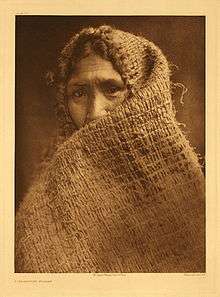
A veil is a piece of sheer fabric that covers all or part of the face. For centuries women covered their hair, neck, ears, chin, and parts of the face with fabric. Each culture created elaborate head wraps for women and men using a shawl, headscarf, kerchief or veil. Very elaborate veiling practices are common in Islam, Africa and Eastern Europe. Women who don't cover their head on a regular basis, often use a veil in traditional wedding and funeral ceremonies.
Wig
Wigs are headpieces made from natural or synthetic hair[4] which may be worn to disguise baldness or thin hair, or as part of a costume. A toupee may be worn by a man to cover partial baldness. In most Commonwealth nations, special wigs are also worn by barristers, judges, and certain parliamentary officials as a symbol of the office.
Purpose
Protection or defense
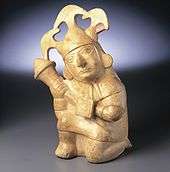
There are also the full range of helmets. There are also hats that are worn for protection from the cold. These include many varieties of fur hats, and also the Canadian tuque.
Fashion

Headgear is also an article of fashion. The formal man's black silk top hat was formerly an indispensable portion of the suit, and women's hats have, over the years, attained a fantastic number of shapes ranging from immense confections to no more than a few bits of cloth and decorations piled on top of the head. Some hats, such as Deep Blue Sea, are showpiece creations created more as works of art than as practical items of fashion, and may be worth thousands or millions of dollars. Recently, the hat as an article of formal wear has fallen out of fashion, though some kinds of hats other than baseball caps may be included in young people's subcultural fashions.
Religious significance
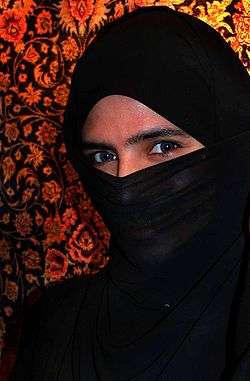
Some headgear is worn for religious practice.
In Judaism, men cover their heads out of reverence for God. Jewish religious headgear for men include small cloth skull-caps, called kippahs or yarmulkes. Some men wear them at all times, others in the synagogue. In Orthodox and Hasidic Judaism, the kippah may also be additionally covered by hats such as fedoras or shtreimels. Traditional married Jewish women cover their hair in various ways, such as with headscarfs, called tichels, snoods, or wigs, called sheitels according to the principles and halacha of tzniut.
Similar to the yarmulke is the zucchetto worn by Roman Catholic clergy. Other forms of apostolic headgear include the mitre, biretta, tasselled cardinal's hat, and the papal tiara. Orthodox Christian clergy and monastics often wear a skufia, a kamilavkion, or a klobuk. See also the fez (clothing). The term red hat, when used within the Roman Catholic Church, refers to the appointment of a Cardinal, a senior Prince of the Church, who is a member of the electoral college that chooses the Pope. On being appointed to the cardinalate, he is said to have received the red hat, or cardinal's biretta. Traditionally Christian women were required to wear a headscarf while in Church, however this custom has been in decline since the 1900s and is only followed by women of certain denominations and cultures.
Male Sikhs are required to wear turbans. Some Sikh women also wear a turban however it is not a requirement for female Sikhs. Turbans are also worn by Muslims especially among Shia Muslims, who regard turban-wearing as Sunnah Mu'akkadah (confirmed tradition).[5]
In Islam, the Hijab, or headscarf, is worn by women because it is considered modest. Muslim men also wear a skullcap called a "kufi" or taqiyah (cap). Until more recent times, men in most Muslim societies were rarely seen without headdress of some sort. The doppa originating in the Caucasus is worn by Kazan Tatars, Uzbeks and Uyghurs. Conservative Muslims in Indonesia and Malaysia, especially in the rural areas, are often seen wearing a thin kopiah.
The black satin headgear called or known as fenta or topi is a pillbox-shaped skullcap, worn by Zoroastrians. It is considered by some in the Zoroastrian religion to be of vital spiritual importance. In earlier times, a saucer-shaped, red-and-white-striped kipah was the hallmark of the Zoroastrian.
Buddhist priests in China wear the bao-tzu (more commonly known as the mao-tzu, 帽子 Mandarin màozi), the classic skullcap that is the most like the Jewish tradition. In Japan, the cap is more in the form of a pillbox and is called the boshi (帽子). Though not of ecclesiastical significance, the Buddhist skullcap does denote something about the priest's standing in the community.
Symbol of status or office
Headgear such as crowns and tiaras are worn in recognition of noble status especially among royalty. Wigs are worn traditionally by judges and barristers of Commonwealth nations. Feathered headpieces, such as the war bonnet of Plains Indian cultures, are worn by various Native North American and South American indigenous peoples.[6]
Etiquette
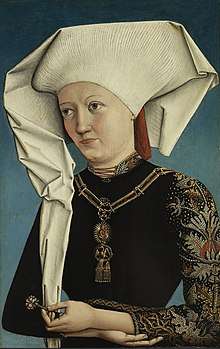

In the Western culture derived from Christian tradition, removing one's headgear is a sign of respect, making oneself more open, humble or vulnerable, much like bowing or kneeling. This is as if to say, "I acknowledge that you are more powerful than I am, I make myself vulnerable to show I pose no threat to you and respect you." Men's hats are traditionally removed in Church, and not removing them is usually frowned upon. Women, however, are required to wear a hat to cover the head in some churches based on 1 Corinthians 11:5.
In the Jewish tradition, the converse idea equally shows respect for the superior authority of God. Wearing a kippah or yarmulke means the wearer is acknowledging the vast gulf of power, wisdom, and authority that separates God from mankind. It is a sign of humility to wear a yarmulke. There is a common phrase that explains this, saying that "there's always something above you" if you're wearing a yarmulke, helping you remember you're human and God is infinite. A Talmudic quote speaks of a righteous man who would "not walk (six feet) with an uncovered head, the (spirit of God) is always above him". Jews also may wear a fur hat or a black hat with a brim.
In Islamic etiquette, wearing headgear is perfectly permissible while saying prayers at a mosque, see taqiyah (cap) for further information.[7]
In the military, there are specific rules about when and where to wear a hat. In the military, hats are generally worn outdoors only, at sea as well as on land; however, personnel carrying firearms typically also wear their hats indoors. Removing one's hat is also a form of salute. Many schools also have this rule due to the fact that many younger men tend to wear baseball caps and this being in relations to gangs depending on the side in which the hat is worn.
Traditionally, a man would remove his hat to show respect for the dead, when a national anthem is played or in the presence of royalty, in a church or courtroom, and during other solemn occasions, when meeting someone, and indoors except in lobbies and corridors of public buildings though there is no actual relationship to uncovered heads and any of those places and situations). A woman may continue wearing her hat, unless she is wearing what is considered a unisex hat, such as a baseball cap, when she should remove her hat as well. Women traditionally do not take off their hats in these situations because they may be carefully pinned to their hair but take off their hats only in their own homes. Though hat etiquette has been relaxed and many people who still wear hats wear them indoors except for solemn situations and at indoor dining tables.
Finally, the hat can be raised (briefly removed and replaced, with either hand), or "tipped" (touched or tilted forward) as a greeting.
Beginnings
There are two types of hats: with brims and without. Necessity and fashion are the reason people wear hats. The first manufactured hats were nothing more than a round piece of leather. A circle of holes about the size of one's head was punched in the leather, and a string was then woven through those holes and pulled tight to hold the hat snugly to the head. The hatband separated the crown from the brim.
The wide floppy brim was tied up with a ribbon, to keep it out of one’s eyes. Some times when the ribbon was off they would see that the brim stayed curled by itself. This led to the hand-curled brim.
Brims were bound with ribbon to keep them from fraying after being trimmed with the knife. Although advancements in materials have eliminated the need for binding the brim, or pinning it up, the custom remains. We must keep our brims curled up because long ago hatters did not know how to stiffen a brim.
When men went off to do battle it was customary to wear a feather from their loved one. Because men were mostly right-handed they lead when sword fighting with the right side. At first they would stick the feather in the adjusting hatband. Unless they wanted to fight blind, surviving duelers moved the feather and knot, to the left side of the hat, where it remains today. As time went on, they would wrap a ribbon around the crown to hold the feather and hide the tie string knot.
When leather turned to velvet some protection was needed to keep the soft fabric from falling on people’s hair, this is where the lining came from. Even though modern hats are stiff enough not to collapse, the custom remains. Individual sizing eliminated the need for the tie string, but the bow remains at the back of the hat, serving as a memorial to bygone hatters. What has evolved from necessity later became fashion.[8]
Hats like the cowboy hat were designed from the fur up, to provide a lightweight all-weather shield from the climatic conditions of the American West. Hats like the baseball cap were designed to provide shade.
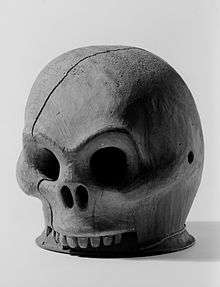
See also
- List of headgear
- List of hat styles
- Chapeaugraphy—an act in which a ring of felt is shaped to resemble many hat types
References
- Children and Orthodontics: Types of Braces, Retainers, Headgear. www.webmd.com/oral-health/guide/children-and-orthodontics WebMD describes common types of orthodontics for children, including braces headgear, and retainers.
- Orthodontic Headgear: Does It Help Improve Teeth?, Healthline
- "Archived copy". Archived from the original on November 25, 2009. Retrieved 2011-05-06.CS1 maint: archived copy as title (link) CS1 maint: BOT: original-url status unknown (link)
- Georga, Yianna. "Syntetic & Natural Wigs". website. YiannaGR. Retrieved 17 September 2013.
- Haddad, Sh. G. F. "The turban tradition in Islam". Living Islam. Retrieved 5 August 2013.
- "Native American Headdresses: Facts for Kids". Retrieved 27 August 2013.
- Ebrahim, Mufti (2003-06-21). "Q & A: Wearing Cap While Praying". Albalagh.net. Retrieved 2013-12-27.
- Wolff, Edwin Daniel. Why We Do It. Manchester, N.H.: Ayer Company Publishers [Freeport, N.Y.: Books for Libraries Press, 1968, reprint of 1929]. ISBN 0-8369-1006-0.
External links
- The Head Covering Movement Christian Head Covering For Today
- Headgear Fashion Plates from The Metropolitan Museum of Art Libraries
| Look up headgear or headdress, headwear, or headware in Wiktionary, the free dictionary. |
| Wikimedia Commons has media related to Headgear. |
